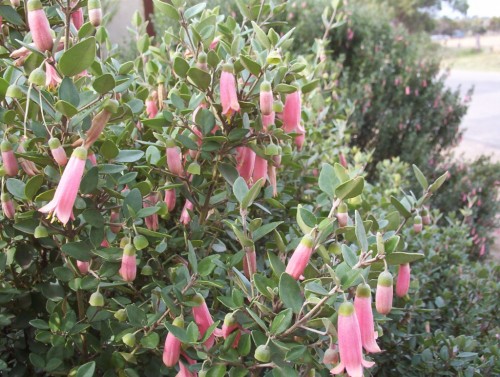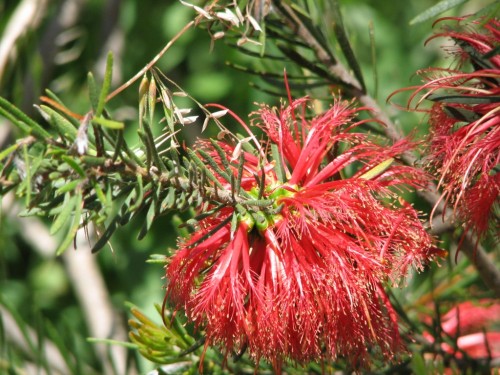Drought Tolerant Correas
Correas are lovely plants and a favourite of mine. There are so many forms and species and there are many very pretty hybrids. There are many drought tolerant ones that I know of. In general they all need good drainage. Trim the plants after flowering. Many can be trimmed to make good hedge plants.
Correa ‘Pink Mist’ has been around for years and is a very hardy small to medium shrub.
Correa reflexa has many hardy forms and one is Correa reflexa ‘Sellick’s Beach’. This one is a good coastal plant and also a good understory plant, growing amonst mallee trees. It forms a low mound to about 30cm high and 1-2m wide. It has dark pink and yellow flowers.
Drought Tolerant Plants With Bottlebrush Flowers
These plants are good value in any garden. Some flower twice in the year. The treatment for all is the same. At the end of flowering, trim the old flowers off to prevent seed pods forming and encourage new growth. The majority will flower on the next lot of growth. The more tips, the more flowers.
Callistemon viminalis is a popular small street tree here and is a picture in flower.
Callistemon phoeniceus is a medium shrub with fiery red brushes (sometimes pinkish red).
Calothamnus homolophyllus is a small shrub with red one-sided bottlebrush flowers.
All of these grow well in alkaine soil, with reasonable drainage and of course would reach their maximum size if there was sufficient rain to push them along. They still grow well in our low rainfall area and in periods of very little rain as is the case this winter.
20 Drought Tolerant Australian Native Plants
Darren Rowse at ProBlogger, the writer of a Blog that I periodically check, has asked folk to make a list of whatever suits their own blog and pass on a link. Some of these activities don’t suit my blog at all but lists are a different matter. I am constantly making lists of plants and seeds and cuttings so, because we have had so little rain this winter, a list of some of my favourite drought tolerant (after establishment) plants seems appropriate. Photos can be seen here.
20 Drought Tolerant Australian Native Plants
Alyogyne huegelii -large shrub
Billardiera (was Sollya) heterophylla Fine leafed form, dark blue flowers -twiner
Callistemon phoeniceus -large shrub
Callistemon viminalis -large shrub
Calothamnus homolophyllus -small shrub
Correa ‘Pink Mist’ -small shrub
Correa reflexa ‘Sellicks Beach’ -small shrub
Eremophila glabra prostrate, red flowered, grey leaf form -ground cover
Eremophila hillii various flower colours -small shrub
Eremophila subteretifolia -ground cover
Goodenia varia -ground cover
Grevillea lavandulacea (Monarto Form)-small shrub
Grevillea ‘Winpara Gem’-medium shrub
Grevillea thelemanniana hybrid -medium shrub
Melaleuca hueglii -large shrub
Melaleuca incana variety ‘Nana’ -small shrub
Melaleuca glaberrimma -small to medium shrub
Nematolepis phebaleoides -small shrub
Olearia picridifolia -small shrub
Scholtzia oligandra -small shrub
Senna sturtii -small to medium shrub
I did have the photos linked to each species named, until I realised that for the programme being used, I needed to save all the photos to another category called Drought Tolerant Native Plants. That is the next job.
Hakeas For Dry Areas
Hakeas are interesting and tough plants to grow. Many are very prickly plants which makes them great for nesting sites for small birds like wrens. These are also good for hedge plants and foot traffic control as well as security. I wouldn’t like to scramble around Hakea mitchellii or Hakea leucoptera for example.
These two plants smother themselves in dense white flowers. They are both native to South Australia and Hakea mitchellii is prevalent around the mallee areas. Like all hakeas they prefer good drainage and an open sunny position. They are easy to raise from seed which should be poked into the surface of the seed raising mix and covered to twice the thickness of the seed with mix and a very thin layer of small washed gravel. The seed can be sown into individual pots or transplanted soon after germinating when the seedling is large enough to handle.
The fruit (seed pod) of hakeas split to give two seeds per fruit. Place older seed pods in a paper bag until opened and the winged seed can be shaken from the fruit. The fruits of a number of species are often used in floral art work as well as a variety of crafts. Children often have fun creating imaginary creatures from the different shaped pods.
Soils
I went looking for some garden loam today. I had this great idea that I would buy something with a lower pH than what is here, dig holes for the fruit trees which must be planted this week, and back fill with the better soil. Then I was going to put a 10cm layer, minimum, on the veggie beds, which will raise the beds and hopefully give some of the veggies a better start. Most like alkaline soil, but I think a pH of 9-10 is a bit much for any self respecting veggie.
Result? Soil with a pH of say 7.5 (I didn’t want much!) is like hen’s teeth around here. The landscape supply place had three lots for me to choose from, all them within the range of pH 8-9. One a loam, another, loam with chook manure added and much favoured for using to grow instant lawn, and a sandy loam mix. I went home feeling quite disheartened especially when the fellow said that they went looking for acid loam and found that it was loam with turkey manure in it to make it acid! What hope is there for we country folk!
End result is that I opted, after some thought, to get the loam thinking that at least is does not have limestone rubble in it. I will still need to work on it with manure and compost and probably sulphur. This could be an interesting experiment.




